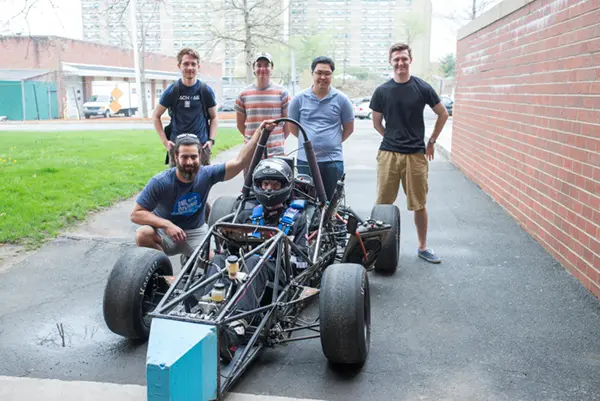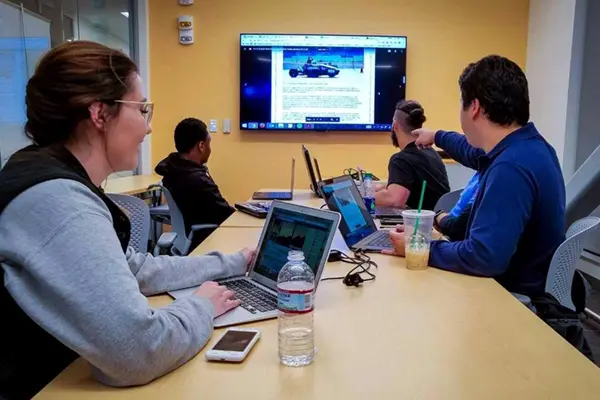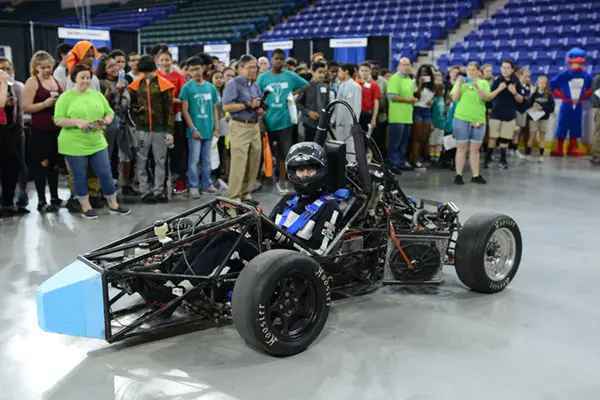
10/29/2018
By David Perry
Sparks cascade from the bar of a metal skeleton. They flicker and die on the concrete floor of the Shell station garage as Brian Craven, a senior mechanical engineering major, welds.
Craven arrived at 7 a.m., three hours after leaving his other job. It’s now 5 p.m. Empty water bottles and coffee cups are strewn along workbenches, near greasy pizza boxes and an array of tools.
Crunch time. The skeleton must become a car chassis soon.
Thirty-six hours later—at 5 a.m. on Father’s Day—11 students from the River Hawk Racing student club hit the road for Lincoln, Neb., and a four-wheel, multiday final exam: The Formula SAE Lincoln North American competition.
From June 20-23, River Hawk Racing competed with the likes of Michigan State University, UCLA, MIT and perpetual piston-pumping powerhouse Texas A&M, which this year lodged its seventh win since 2000.
In 2017, its first competition in five years, River Hawk Racing’s goal was to build a car and just make it to the competition. This year, the goal was to do better than in 2017.
Formula SAE (part of SAE International, formerly known as the Society of Automotive Engineers) is, at its heart, a collegiate engineering competition, about research, design and manufacturing a car that—if it makes it through the preliminaries—can reach speeds of up to 60 mph. But it’s also about management, finance and marketing.
“The whole purpose of Formula SAE is not to just build the car and win the race, but to teach engineers cross-functional teaming that is required for product development.”The main race in this competition is one of readiness.
“We got a late start this year,” says mechanical engineering senior Zach Tenaglia. “The schedule didn’t go as planned, but luckily, we have a lot of people who are good with the hands-on part of it.”
“And right now,” says Tenaglia, wearily surveying the wires, the pedal boxes and the Ninja 650 motorcycle engine that have yet to find their final places on the chassis, “we are tired.”
DAVID VS. GOLIATH
The River Hawks were underdogs, say team members.
“Well, here we are in a Shell garage in Dracut, when a lot of the teams we’re competing against have million-dollar shops of their own,” says Tenaglia. “But we go to compete and people remember us. It’s not like we wouldn’t like to have what they do. We just work harder. The dedication here is unparalleled.” (The Shell station, on Lakeview Avenue, is owned by Nouria Energy Corp., which donates the garage’s use to River Hawk Racing.)
Lincoln was challenging. River Hawk Racing placed 64th of 80 teams overall, and 58th in the Presentation category. But the team earned an impressive fourth place in the Cost category, for which judges meticulously studied team budgets and spending. The River Hawks raised about $20,000, which paid for everything from car parts to travel expenses.

The team never got to the driving or “dynamic” events. The car wasn’t starting, so it couldn’t undergo the brake test. There was disappointment, sure, but the team is focused on a longer race.
“Going to Nebraska was a lot of fun,” says Louis Cirignano, a senior business student. “Would we have liked to have done better? Sure. But this is about learning, and we learned a lot by doing the wrong things.” “The goal this year was to do better than we did the year before, which we did,” said mechanical engineering graduate Kevin Nguyen ’18, who remains River Hawk Racing’s president.
“In 2017, it was about physically making it to the competition,” he says. “There were 109 teams at the competition, and we were 109th. Though we did not achieve as much as we had hoped this year, we did make a lot of relative improvements in how we conducted the trip and some of our static events.”
SHIFTING GEARS
River Hawk Racing was hatched in 2006 by a small group of Francis College of Engineering students. UML teams made it to Formula SEA competitions in 2008, ’10 and ’12 before a five-year break.
Nguyen—a Melrose native who says he’s been under the spell of automobiles for as long as he can remember—was instrumental in bringing it back to life. When he arrived at UML, Nguyen quickly discovered that River Hawk Racing could use an infusion of fresh blood.
Others joined the club, but it was “mostly just mechanical engineering students, fixated on the technical work,” says Nguyen, who, along with ME major Spencer Culpepper, knew they needed more diversity.
In the summer of 2017, the pair hooked up with business administration major Kelly Foley, a member of the Collegiate DECA club. Foley became an essential cog in formulating a general business plan for River Hawk Racing, until she left in January to start a job with iRobot.

A business major with a concentration in entrepreneurship and finance, Cirignano leads the part of the team that crafts business plans, does cost analysis and handles money management for River Hawk Racing. He is also looking to form a board of directors, which will include students and alumni from various fields.
A good candidate for that board is industrial management alumnus Cuneyt Oge ’75, an auto industry consultant who is a former president and chair of the board of directors at SAE International.
“The whole purpose of Formula SAE is not to just build the car and win the race, but to teach engineers cross-functional teaming that is required for product development,” says Oge. “You have people that become chief engineers, you’ve got a marketing person, you’ve got somebody who worries about the cost. They take on these roles as a team and work as a team, which is exactly the way you work in the workplace.”
Formula SAE is formative for automotive engineers, says Oge, who points out that the ranks of automakers like Ford, GM and Toyota have stocked their engineering teams with Formula SAE veterans. And Tesla founder Elon Musk pays particular attention to them, Oge says.
“For students who want to work in the auto industry, it’s an opportunity to meet people from huge manufacturers,” says Tenaglia. “Last year, a couple of our folks landed internships.”
Formula SAE offers great hands-on experience, he adds, pointing out that just like “cars are a system of very small, complicated parts and subsystems working together,” so, too, are successful businesses.
“The cool thing about River Hawk Racing,” he says, “is that it’s not just mechanical engineering students. It’s people majoring in electrical engineering, business, finance—students who are not used to working together.”
But they’re getting better at it.
The team has already started work on next year’s model, says Nguyen, who landed a sales engineer job at Aligned Vision, a fabrication management systems company.
He has no plans to leave River Hawk Racing behind just yet.
“Our goal for next year,” he says, “is to do better than this year.”
